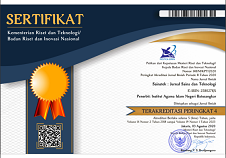TUMBUHAN YANG DIKUNJUNGI LEBAH PEKERJA Apis (Hymenoptera: Apidae) DI SUMATERA BARAT
Abstract
Research about plant visited by Apis forager was conducted at altitude < 500 m and 600-1400 m of West Sumatra from December 2009-July 2010. The plant visited by forager was collected at radius 500 m from nests in fruits cropping, coffea and cinnamom plantation and forest edge. Honeybee from genus Apisvisit on plant consisted of four species, those are A. andreniformis, A. cerana, A. dorsata and A. koschevnikovi. Plant visited by forager Apis consisted of 61 species belong to 26 families. The number of 36 plant species found at lowland and highland, 20 species only at lowland and five species at highland. Most of plant species visited by Apis forager are Asteraceae and Leguminoceae. About 29 plant species visited by Apis were agriculture crop and 32 species of non agriculture. Apis andreniformis visited 29 plant species, A. cerana 56 species, A. dorsata 57 species and A. koschevnikovi one plant species. Cucumis sativus was visited by four bee species, Galiansoga farviflora was visited only by A. cerana. Five plant species (Rorippa indica, Cinnamomum burmanii, Nasturrium indicum, Rorippa indica and Eryngium foetidum) were visited by only A. dorsata. Other three plants species (Mangifera indica, Cytrus aurantifoliaand Oryza sativa) were visited by A. cerana and A. andreniformis, 31 plant species were visited by A. cerana and A. dorsata, 21 species were visited by A. andreniformis, A. cerana and A. dorsata.
Keywords: lebah madu, Apis forager, food source plant, visit
Full Text:
PDF (Bahasa Indonesia)References
Anonim. 2001. Profil Ekosistem: Ekosistem hutan Sumatera di dalam “Hotspot” keanekaragaman hayati sundaland Indonesia. (versi terakhir) 11 De-sember, 2001.
Bhuiyan KH, Hossain HM, Bari MN and Khanan MR. 2002. Identification of bee plants and analysis of honey collected from different plant souerces. Pakistan Journal of Biological Sciences 5 (11): 1199-1201.
Free JB and Furson AW. 1983. Foraging be-havior of honey bee on oil seed rape. Beeword. Vol. 64. No. 1. p. 22-24.
Dag,A and Eisikowitch D. 1995. The influ-ence of hive location on honeybee for-aging activity and fruit set in melons grownin plastic greenhouses. Api-dologie. 26: 512-519.
Eltz T, Bruhl CA, van der Kaars S, Cey VK and Linsensmair KE. 2001. Pollen for-aging and resource partitioning of sting-less bees in relation in flowering dynaimics in a Southeast Asian Tro-pical raintforest. Insectes Sociaux. p. 273-289).
Erickson EH and Atmowidjoyo AH. 1997. Bermuda grass (Cynodon dactylon) as a pollen resource for honey bee colonies in the lower Clorado river agro-ecosystem. Apidologie. 28. p 57-52.
Liferdi. 2008. Lebah polinator utama pada ta-naman hortikultura. Balai Penelitian Tanaman Buah Tropika. Iptek hor-tikultura. No. 4 - Agustus 2008.
Klein A-M, Steffan-Dewenter I and Tscharntke T. 2003. Bee pollination and fruit set of Coffea arabica and C. canephora (Rubiaceae). American Jour-nal of Botany. 90 (1): 153-157.
MacKenzie KE. 1994. The foraging behaviour of honey bees (Apis mellifera L) and bumble bees (Bombus spp) on cran-berry (Vaccinium macrocarpon Ait). Apidologie. 25: 375-383.
Mahmood AN and Furgala M. J983. Effect of polination by insects on seed oil perentage of oilseed sunflower. Ameri-can Bee Juornal. Vol. 123. No. 9. p. 663-666.
Manaan A. 1997. The role honeybees on the polination of coconut mixed-croping. Indonesian Agriculture Risearch & De-velopment Jurnal. Volume 19, No. 3.
Mardan M. 1995. Apis dorsata honey hunting/gathering ecotour in tropical Asia. Beenet Online. Vol. 1. No. 3. p. 10-12.
Michener CD. 1974. The social behavior of the bees a comparative study. The Belknap Press of Havard University. Cambridge. Massachusetts.
Muntamah L. 2009. Aktifitas Apis cerana mencari polen dan identifikasi polen diperlebahan tradisional di Bali. Tesis. Sekolah Pascasarjana Institut Pertanian Bogor. Bogor.
Notodirnedjo S. 1990. Pengaruh pengadaan lebah, penyerbukan buatan dan pern-berian GA3 terhadap pertumbuhan pe-neratif tanaman apel (Malus sylvestris Mill) varietas rome beaty. Agrivita. Vol. 3. No.3. p. 65-69.
O Toole C and Raw A. 1991. Bees of the world. Biandford. London.
Ramaldho M, Kleinert-Giovenini A and Imperatriz-Fenzeca VL. 1989. Utili-zation of floral resources by spe-sies of Melipona (Apidae, Melipo-ninae): flo-ral preferences. Apidologie. 20: 185-195.
Salmah S. 1987. Jenis-jenis lebah pengahasil madu dan potensinya di Sumatera Ba-rat. Laporan penelitian. BKS-B dan USAID Pusat Penelitian Universitas Andalas. Padang.
Salmah S. 1989. Tempat dan volume beberapa jenis lebah yang terdapat di Sumatera (Hymenoptera: Apidae). Seminar dan Kongres Biologi Nasional IX di Pa-dang. Padang, 10-11 Juli 1989.
Salmah S. 1990. Jenis lebah sosial (Apidae) dan distribusinya di Taman Nasional Kerinci Seblat. Laporan penelitian. Departemen Pendidikan dan Kebu-dayaan. Pusat Penelitian Universitas Andalas Padang.
Tiwari P, Tiwari JK and Ballabha R. 2010. Studies on sources of bee-forage for rock bee (Apis dorsata F.) from Garh-wal Himalaya, India: a Melisso-paly-nogaical Approach. Natural and Scien-ce. 8 (6).
Tjitrosoepomo G. 2000. Morfologi tumbuhan. Gajah Mada University Press.
DOI: http://dx.doi.org/10.31958/js.v5i1.80
Refbacks
- There are currently no refbacks.
Copyright (c) 2016 Jasmi Jasmi

This work is licensed under a Creative Commons Attribution-NonCommercial-NoDerivatives 4.0 International License.
Indexed by:
__________________________________________________________________________
Sainstek: Jurnal Sains dan Teknologi
ISSN 2085-8019 (print) | 2580-278x (online)
Published by Institut Agama Islam Negeri Batusangkar
Email: sainstek@iainbatusangkar.ac.id
This work is licensed under a Creative Commons Attribution-NonCommercial-NoDerivatives 4.0 International License.















